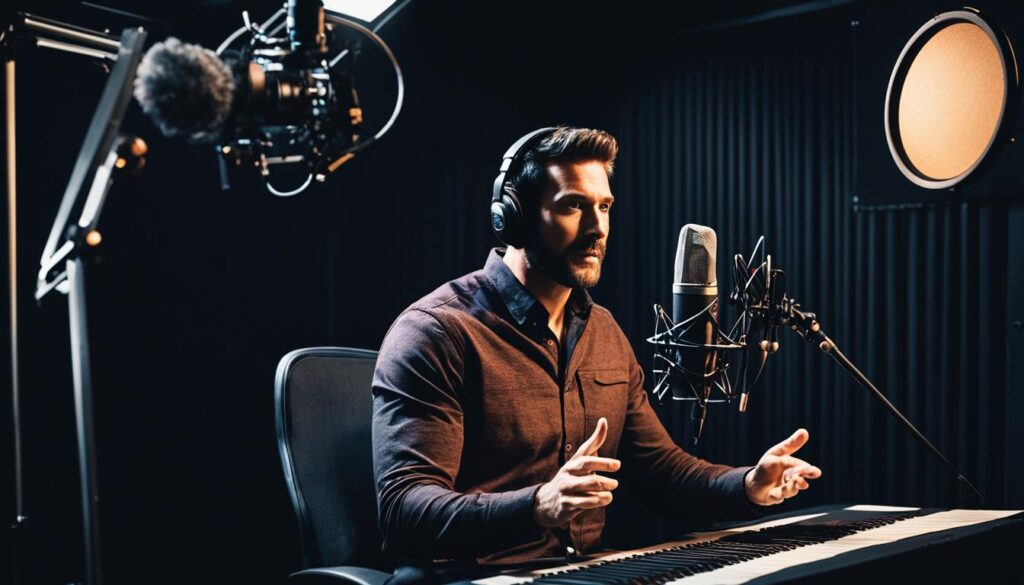As an avid audiobook listener, I’ve come to realize the immense impact that audiobook narrator performances have on my overall listening experience. The way a narrator brings a character to life through their voice and intonation can make or break my connection to the story.
This led me to delve deeper into the world of audiobook narrator character analysis. Understanding the techniques and strategies used by voice actors to portray characters effectively can enhance the way we experience audiobooks and give us a greater appreciation for the art of narration.

Key Takeaways:
- Audiobook narrators play a vital role in bringing characters to life through their performance.
- Well-developed characters are crucial to the success of an audiobook.
- Narrators use various techniques and strategies to effectively portray characters.
- Vocal techniques, emotion, and intonation are key to bringing audiobook characters to life.
- Analyzing specific audiobook character performances can enhance our understanding and appreciation of the art of narration.
The Role of Audiobook Narrators
When it comes to audiobooks, the narrator’s role is crucial. They have the responsibility of bringing the story to life, engaging the listener, and creating immersive experiences. Without the right narrator, even the best-written books may not resonate with the audience as intended.
A skilled audiobook narrator must have an excellent command of the language, an engaging voice, and the ability to portray various characters convincingly. They must also be mindful of the pacing, tone, and inflection, to ensure that the listeners remain engrossed and emotionally invested in the story.
Notably, the narrator’s impact on audiobooks goes beyond mere storytelling. Narrators can add depth to the characters, evoking emotions, and setting the tone for the entire book. They can emphasize the themes of the story, and in some cases, create dialogue that brings a unique perspective to the narrative.
Overall, audiobook narrators play a vital role in shaping the listeners’ experience. They can turn an everyday book into a captivating story that resonates with the audience for years to come.
Understanding Audiobook Characters
When it comes to audiobooks, well-developed characters are essential to the overall success of the narrative. As a listener, we rely on the narrator to bring these characters to life through their voice acting, allowing us to connect with and invest in their stories.
Strong audiobook characters are often multi-dimensional, with rich backstories and complex motivations that drive the plot forward. They can be heroes or villains, flawed or perfect, but they must be interesting and relatable enough to keep the listener engaged.
While some listeners may be drawn to the plot or the genre, it is often the characters that keep them coming back for more. A great protagonist or antagonist can make an audiobook unforgettable and inspire listeners to recommend it to others.
“Great characters are the backbone of any successful audiobook. They allow the listener to connect emotionally with the narrative, creating a memorable and impactful experience.”
As audiobook narrators, we must strive to convey the essence of each character in our performance, bringing them to life through vocal nuance and interpretation. By understanding the significance of well-developed audiobook characters, we can create a more engaging and immersive listening experience for our audience.
Techniques Used by Audiobook Narrators
As an audiobook narrator, my job is to bring the characters to life through my voice. To do this effectively, I use a variety of techniques and strategies to develop unique voices and portrayals for each character.
One essential technique is understanding the character’s personality, motivations, and background. This helps me create a distinct voice that aligns with the character’s traits and brings authenticity to their portrayal.
Another technique is utilizing appropriate pacing, emphasis, and tone to emphasize the character’s emotional state and emphasize key plot points. Dialogue delivery is another critical aspect that involves understanding how to differentiate each character’s voice to make conversations between them flow naturally.
Additionally, I use vocal inflections to indicate a character’s mood or attitude, bringing life to the narration. By using varying tones, I can enhance the dramatic effect of the story, leading to a more engaging experience for the listener.
Overall, the key to successful character portrayal is to find the right tone, pace, and emphasis for each character in the story. By mastering these techniques and understanding the characters’ motivations and backgrounds, I can deliver an exceptional performance that captivates the listener and brings the audiobook to life.
Bringing Characters to Life through Voice Acting
As an audiobook narrator, it’s not enough to just read the book out loud. Bringing characters to life through voice acting is an art that requires a deep understanding of the character’s backstory, personality, and emotions. Voice actors use a range of techniques, including vocal inflection, pacing, and tone, to portray each character in a dynamic and engaging way.
One important technique that voice actors use is adjusting their pitch and intonation to match the character’s age, gender, and personality. For example, a deep, slow voice might be used to portray an older, wise character, while a higher-pitched, more energetic voice might be used to bring a child to life. By altering their vocal delivery in this way, voice actors can create a more immersive and believable experience for the listener.
Another crucial aspect of bringing characters to life through voice acting is conveying emotion. Whether it’s sadness, anger, or joy, the voice actor must effectively communicate the character’s emotional state to the listener. This requires careful attention to pacing, tone, and emphasis, as well as an understanding of the character’s backstory and motivations. By conveying authentic emotion, voice actors can create a deeper connection between the listener and the character, enhancing the overall listening experience.
Ultimately, the success of an audiobook often hinges on the skill of the narrator in bringing characters to life through voice acting. By using a range of vocal techniques and conveying authentic emotion, voice actors can create memorable and engaging performances that transport listeners to new worlds and help them connect with unforgettable characters.
Analyzing Different Audiobook Character Archetypes
As an audiobook narrator, I have noticed that there are certain character archetypes that pop up frequently in storytelling. These archetypes are powerful tools that can help an author quickly establish a character and create an emotional connection with the reader.
One of the most common audiobook character archetypes is the hero. This archetype is typically brave, loyal, and selfless, and often serves as the protagonist of the story. The hero archetype can be found in many different genres, from fantasy to mystery to romance.
Another common audiobook archetype is the sidekick. This archetype is often the hero’s best friend, and provides support, comic relief, and often important information to move the story forward.
The villain is another archetype frequently encountered in audiobooks. The villain is often the character opposing the hero, causing conflict and driving the story forward. Villains can take many forms, from brutal physical opponents to cunning manipulators.
Of course, these are just a few of the many audiobook character archetypes that authors can use. By analyzing and understanding these archetypes, audiobook narrators can better connect with the characters and portray them more effectively.
“Character archetypes are like tools in a toolbox. You can use them to build a compelling narrative, but you also need to make sure you use them in a unique and interesting way to keep your story fresh and engaging.”
Character Analysis Case Studies
Now that we’ve covered the importance of well-developed characters and the various techniques used by audiobook narrators to portray them effectively, let’s dive into some real-world examples of character analysis in action.
One standout performance that comes to mind is the portrayal of Holden Caulfield in J.D. Salinger’s “The Catcher in the Rye,” narrated by actor Tim Robbins. Robbins captures Caulfield’s signature blend of cynicism, vulnerability, and wit, bringing the character to life in a way that resonates with listeners.
Another great example is the narration of Mark Watney in Andy Weir’s “The Martian,” performed by actor R.C. Bray. Bray’s portrayal of Watney’s humor, resourcefulness, and determination perfectly captures the essence of the character and makes for an engaging and memorable listening experience.
These case studies demonstrate the impact that skilled narration can have on character development and the overall narrative. By analyzing the choices made by these talented voice actors, we can gain valuable insights into the art of character portrayal and continue to push the boundaries of audiobook performance.
The Future of Audiobook Character Analysis
As audiobooks continue to grow in popularity, character analysis is becoming increasingly important. In the future, audiobook character analysis may encompass more advanced technologies, such as AI, that can identify vocal patterns and emotional nuances in a narrator’s delivery.
With advancements in technology, character analysis may also become more personalized and interactive. Listeners may be able to provide feedback and preferences, allowing for a more tailored listening experience that takes into account their individual tastes and interests.
Additionally, as audiobooks continue to gain mainstream acceptance, the demand for high-quality narration will likely increase. This in turn may lead to more investments in narrator training and development, resulting in an even greater emphasis on character analysis and performance.
Overall, the future of audiobook character analysis is bright, with exciting possibilities for both narrators and listeners. As technology continues to evolve and the industry grows, we can expect to see new and innovative ways to analyze and enjoy audiobook characters.
